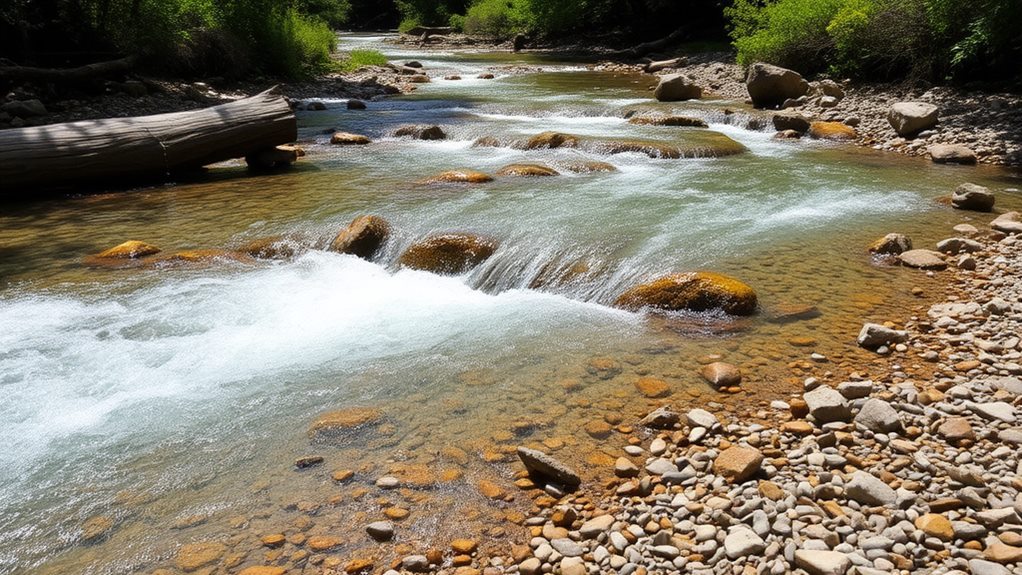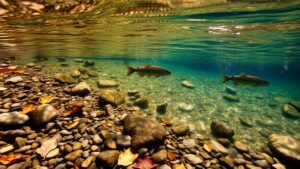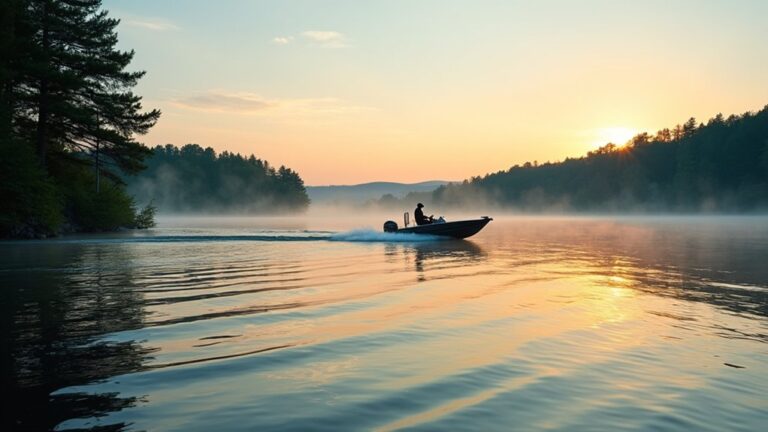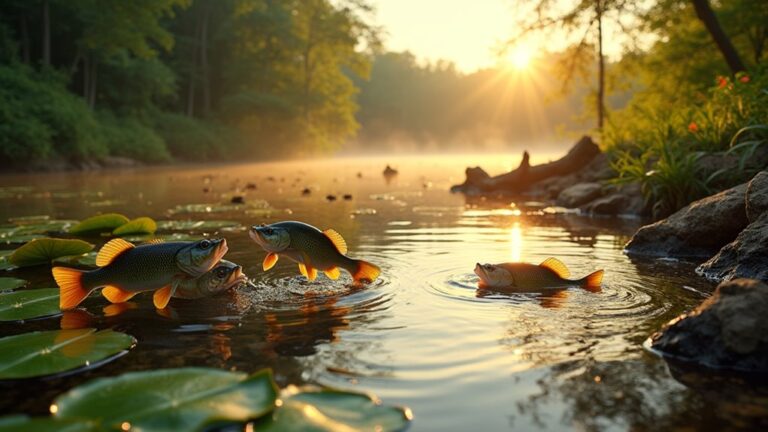Trout aren't random in their spawning choices – they're actually quite picky about where they lay their eggs. They'll seek out spots with temperatures between 50-65°F, typically in shallow waters 1-3 feet deep with moderate current flow. You'll find them favoring areas with clean gravel bottoms, which protect their eggs and allow proper oxygen circulation. They also prefer locations near protective cover like boulders or vegetation, keeping both eggs and newly hatched fry safe from predators. Understanding these precise spawning requirements gives you deeper insights into trout behavior and habitat preferences.
Water Temperature and Seasonal Timing

While many factors influence trout spawning, water temperature plays the most critical role in determining when these fish will reproduce. You'll find that trout are quite particular about water temps, typically waiting until the water reaches between 60°F and 65°F before they begin their spawning activities.
If you're looking to understand spawning patterns, you'll notice they vary considerably by region. In cooler areas, trout usually spawn from September to October, but in warmer locations, you might spot spawning behavior as early as February. The spawning season can stretch all the way into November, depending on local conditions.
What's particularly interesting is that these fish don't just spawn once and call it quits. Under ideal conditions, you'll find trout returning to spawn multiple times within a season, typically waiting 10-12 days between attempts.
However, if the water's too cold, they'll simply wait it out – these fish won't rush into spawning until conditions are just right. It's nature's way of ensuring the best possible chance for their offspring's survival.
Gravel Size and Bottom Composition
Beyond temperature considerations, the physical makeup of a stream bed plays a major role in trout spawning success. When you're studying trout spawning habits, you'll notice that these fish are quite particular about their gravel preferences, and for good reason. The right-sized gravel creates perfect pockets for eggs while allowing oxygen-rich water to flow through.
You'll find that resident brown trout tend to favor smaller gravel areas, while their salmon cousins opt for coarser material. It's not just about the rocks, though – you're looking at a whole package deal. Clean, flowing water is vital because it keeps the gravel free from suffocating silt that could harm developing eggs. Think of it as nature's water filtration system!
Near these gravelly spawning grounds, you'll often spot larger boulders, which aren't just decorative. They're actually significant features that brown trout use to their advantage, creating protected spawning zones in the smaller gravel deposits nearby.
When you combine these elements – proper gravel size, clean water, and strategic boulder placement – you've got the perfect recipe for successful trout reproduction.
Water Depth and Flow Rates

Water depth and flow rates create a delicate balance in trout spawning sites. If you're studying trout spawning behavior, you'll notice these fish aren't random in their choices – they're quite particular about where they lay their eggs.
You'll typically find them in shallow waters between 1 to 3 feet deep, where they can easily access the gravelly bottom.
The flow rate is just as vital as depth. You'll observe that trout prefer areas where water moves at a moderate to fast pace, roughly 1 to 2 feet per second. This isn't just a preference – it's critical for egg survival. The moving water keeps oxygen levels high and helps prevent sediment from settling on the eggs.
You won't find many trout spawning in deep, slow-moving pools, even if they might hang out there at other times. Instead, look for riffles and turbulent areas where water tumbles over rocks.
These spots maintain the perfect temperature range of 50°F to 60°F and provide the oxygen-rich environment that developing eggs need. It's nature's perfect nursery, carefully selected by generations of spawning trout.
Natural Cover and Protection
Under the surface, trout rely heavily on natural cover for successful spawning. When you're looking at prime spawning locations, you'll notice that trout consistently choose areas with abundant rocks, vegetation, and boulders. Much like early morning fishing yields better results, these protected areas offer ideal conditions for reproduction.
These natural structures aren't just hiding spots – they're crucial components of a successful spawning ground, providing protection from predators and harsh conditions while maintaining stable water temperatures.
If you're wondering what makes these covered areas so special, here are three key benefits that natural cover provides during spawning:
- Protection from predators, allowing adult trout to focus on reproduction without constant threat
- Stable water temperatures that help regulate spawning timing and egg development
- Creation of oxygen-rich environments through water movement around structures
You'll find that brown trout are particularly selective about their spawning spots, preferring shallow, gravelly areas near natural cover where water flows freely.
The combination of protection and ideal conditions isn't just a preference – it's a survival strategy. When trout locate these perfect spots with the right mix of cover and substrate, they're more likely to return year after year, creating generational spawning grounds.
Oxygen Levels and Water Quality

Natural cover plays its part in trout spawning success, but oxygen-rich water serves as the lifeblood of these reproductive zones. You'll find that trout are incredibly particular about where they lay their eggs, and water quality plays a vital role in their decision-making process.
When you're looking at prime spawning locations, you'll notice that the best spots feature clean, flowing water that's rich in oxygen. These areas often occur near underground springs, where fresh, oxygenated water bubbles up through gravel beds. The higher oxygen levels you'll find in these locations aren't just a luxury – they're critical for egg development and survival.
Think of the gravel substrate as nature's incubator. You'll see trout choosing areas where clean water flows through loose gravel, creating the perfect environment for their eggs to develop. It's like a natural filtration system that keeps oxygen levels high and harmful contaminants low.
What you mightn't realize is that pollution can be a real deal-breaker for spawning trout. Poor water quality doesn't just affect adult fish – it can make entire stretches of otherwise suitable habitat completely unsuitable for reproduction.
Access to Food Sources
When successful spawning is your goal, you'll find that food availability plays a crucial role in where trout choose to lay their eggs. These clever fish don't just pick any spot at random – they're looking for locations that'll provide abundant nutrition for both themselves and their future offspring.
You might wonder why food sources matter so much for spawning trout. Here are three key reasons:
- Adult trout need plenty of energy during spawning, and having food nearby means they won't have to swim far to grab a quick meal.
- Once the eggs hatch, young fish need immediate access to small prey like aquatic insects to survive their first few weeks.
- Areas rich in food sources typically indicate a healthy ecosystem, which means better chances of survival for the whole family.
When you're out on your next fly fishing adventure, pay attention to spots where you see lots of insect activity – these are often prime spawning locations.
Trout are natural strategists, and they'll typically choose areas where they can find a buffet of crustaceans, small fish, and other tasty morsels that'll keep them well-fed throughout the spawning process.
Predator-Free Zones

Every successful trout spawning location shares one essential feature: protection from predators. You'll find that trout carefully select spots where their eggs and newly hatched fry face minimal risk from hungry aquatic neighbors, ensuring the next generation has the best chance of survival.
When you look at typical spawning sites, you'll notice they're often in shallow, gravelly areas where larger predatory fish can't easily maneuver. These locations give adult trout a significant advantage, as they can lay their eggs without constant threat from larger species.
Nature provides additional security through rocks and vegetation, which create perfect hiding spots for both eggs and fry during the vulnerable incubation period.
Smart trout also seek out areas with gentle water flow, away from the busy sections of rivers and streams where predators typically congregate. You'll observe that they prefer quiet, undisturbed zones where eggs won't be swept away by strong currents.
This strategic choice of spawning grounds in low-traffic areas, combined with natural cover and shallow waters, gives their offspring the protection they need during those vital early stages of development.
Historical Spawning Success Areas
Traditional spawning grounds have proven their worth through generations of successful trout reproduction. You'll find that these time-tested locations share specific characteristics that make them ideal for trout to lay their eggs and guarantee the survival of their species.
Through years of observation, anglers and researchers have identified three key features of historical spawning spots:
- Shallow, gravelly areas in feeder creeks and headwaters, where well-oxygenated water flows steadily over the rocks.
- Cold-water regions enriched by underground springs, providing the perfect temperature and oxygen levels for egg development.
- Species-specific locations, with brown trout favoring smaller gravel pockets while rainbow trout prefer tailouts.
If you're studying trout spawning patterns, you'll notice that these historical sites aren't random choices. They've been carefully selected by countless generations of trout, creating a natural legacy of successful reproduction spots.
The combination of proper water temperature, suitable gravel size, and adequate oxygen levels makes these locations prime real estate in the underwater world.
These time-honored spawning grounds continue to play a vital role in maintaining healthy trout populations.
Stream Structure and Characteristics

Stream features play an essential role in determining ideal trout spawning locations. You'll find that the physical characteristics of a stream directly influence where trout choose to lay their eggs, with certain elements proving more attractive than others. The presence of well-oxygenated, gravelly areas in shallow waters creates perfect conditions for egg development and larval survival.
When you're examining stream structure, you'll notice that underground springs are particularly significant. These natural features provide a consistent flow of oxygen-rich water that trout absolutely love for spawning.
Additionally, you'll discover that feeder creeks and headwaters often create ideal spawning conditions, especially where they merge with larger waterways.
The substrate composition matters tremendously, too. While brown trout prefer smaller gravel pockets, you'll observe that rainbow trout gravitate toward tailouts with coarser materials. These preferences aren't random – they've evolved to maximize survival rates of their offspring.
During the fall months, particularly September and October, you'll see brown trout actively seeking out these perfect combinations of stream features for their spawning activities.
Frequently Asked Questions
How Do Trout Know When to Spawn?
You'll find that trout spawn primarily when water temperatures reach 55-65°F. They'll respond to these environmental cues, along with factors like water quality and salinity, to time their spawning during warm months.
What Is the Trout Habitat Preference?
You'll find trout thriving in cold, clean waters with plenty of gravel. They prefer well-oxygenated streams, underground springs, and shallow areas with suitable substrate for spawning and protecting their eggs.
Why Are Trout Attracted to Spinners?
You'll find trout are drawn to spinners because they're attracted to the flashing, spinning motion that mimics prey fish. The vibrations and reflective surfaces trigger their predatory instincts, making them strike.
Why Do Trout Go Upstream to Spawn?
You'll find trout swimming upstream to spawn because they're seeking clean, oxygen-rich gravel beds and cooler water temperatures. This natural instinct helps them protect their eggs and guarantee better survival rates for offspring.




